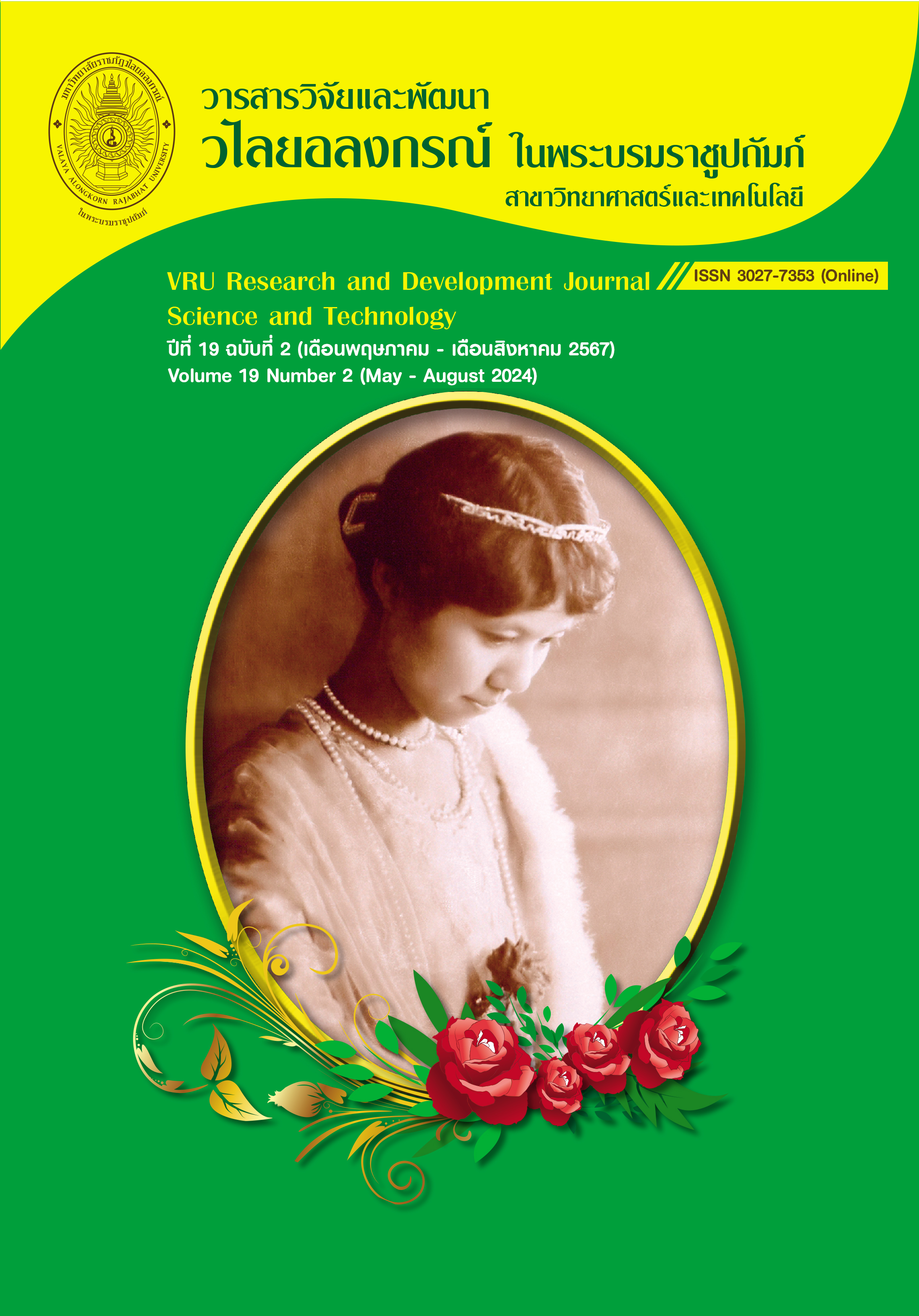USE OF PUMICE STONE AND OYSTER SHELL WASTE IN GEOPOLYMER MORTAR
Main Article Content
Abstract
The objective of this research was to study the properties and durability of geopolymer mortar using pumice stone mixed with oyster shell waste as the starting powder material. The pumice (GPM) to ground calcined oyster shell (GOS) ratios were 100:0, 75:25, 50:50, 25:75, and 0:100 by weight. The study tested the properties and durability of geopolymer mortar, viz., flow values, compressive strength, strength loss of mortar immersed in sodium sulfate solution, and weight loss of mortar immersed in sulfuric acid solution. The results of the study found that flow values of geopolymer mortar increased with increased GOS volume. The use of GPM mixed with GOS in the proportion of 25:75 by weight was a maximum compressive strength of 26.6 MPa at 90 days. The strength loss of mortars by 5% sodium sulfate solutions for 90 days did not show negative effects on the compressive strength of geopolymer mortar made from GPM mixed with GOS. However, the damage caused by the sulfuric acid solution tended to increase as the amount of GOS increased. The research results showed that geopolymer material from pumice stone mixed with oyster shell waste could be used as a cementitious material in concrete work with low compressive strength, in which sulfate or sulfuric acid resistance is remarkable.
Downloads
Article Details
ลิขสิทธิ์บทความวิจัยที่ได้รับการตีพิมพ์เผยแพร่ในวารสารวิจัยและพัฒนา วไลยอลงกรณ์ ในพระบรมราชูปถัมภ์ ถือเป็นกรรมสิทธิ์ของสถาบันวิจัยและพัฒนา มหาวิทยาลัยราชภัฏวไลยอลงกรณ์ ในพระบรมราชูปถัมภ์ ห้ามนำข้อความทั้งหมดหรือบางส่วนไปพิมพ์ซ้ำ เว้นแต่จะได้รับอนุญาตจากมหาวิทยาลัยเป็นลายลักษณ์อักษร
ความรับผิดชอบ เนื้อหาต้นฉบับที่ปรากฏในวารสารวิจัยและพัฒนา วไลยอลงกรณ์ ในพระบรมราชูปถัมภ์ เป็นความรับผิดชอบของผู้นิพนธ์บทความหรือผู้เขียนเอง ทั้งนี้ไม่รวมความผิดพลาดอันเกิดจากเทคนิคการพิมพ์
References
Ahmari, S., Ren, X., Toufigh, V., & Zhang, L. (2012). Production of geopolymeric binder from blended waste concrete powder and fly ash. Construction and Building Materials, 35(2012), 718 - 729.
ASTM Standard C109/C109M-20b. (2020a). Standard test method for compressive strength of hydraulic cement mortars (using 2-in. or [50 mm] cube specimens). West Conshohocken, PA: ASTM International.
ASTM Standard C1437-20. (2020b). Standard test method for flow of hydraulic cement mortar. West Conshohocken, PA: ASTM International.
ASTM Standard C267-20. (2020c). Standard test methods for chemical resistance of mortars, grouts, and monolithic surfacings and polymer concretes. West Conshohocken, PA: ASTM International.
ASTM Standard C618-19. (2019). Standard specification for coal fly ash and raw or calcined natural pozzolan for use in concrete. West Conshohocken, PA: ASTM International.
Chen, W., & Zhu, Z. (2018). Utilization of fly ash to enhance ground waste concrete-based geopolymer. Advances in Materials Science and Engineering, 2018, 1 - 11.
Chindaprasirt, P., Phoo-ngernkham, T., Hanjitsuwan, S., Horpibulsuk, S., Poowancum, A., & Injorhor, B. (2018). Effect of calcium-rich compounds on setting time and strength development of alkali-activated fly ash cured at ambient temperature. Case Studies in Construction Materials, 9, e00198.
Davidovits, J. (1991). Geopolymers - Inorganic polymeric new materials. Journal of Thermal Analysis, 37(8), 1633 - 1656.
Gencel, O. (2015). Characteristics of fired clay bricks with pumice additive. Energy and Buildings, 102, 217 - 224.
Mawlod, A. O., Bzeni, D. K. H. A., & Alzeebaree, R. (2023). Performance of Slag-Pumice-Based Alkali-Activated Mortar at Ambient Environment. Iran J Sci Technol Trans Civ Eng, 47, 2131 - 2147.
Nasaeng, P., Wongsa, A., Cheerarot, R., & Sata, V. (2022). Strength enhancement of pumice-based geopolymer paste by incorporating recycled concrete and calcined oyster shell powders. Case Studies in Construction Materials, 17, e01307.
Nehdi, M. L., Suleiman, A. R., & Soliman, A. M. (2014). Investigation of concrete exposed to dual sulfate attack. Cement and Concrete Research, 64, 42 - 53.
Ojha, A., & Aggarwal, P. (2023). Durability performance of low calcium Fly ash-Based geopolymer concrete, Structures, 54, 956 - 963.
Pangdaeng, S., Phoo-ngernkham, T., Sata, V., & Chindaprasirt, P. (2014). Influence of curing conditions on properties of high calcium fly ash geopolymer containing Portland cement as additive. Materials and Design, 53, 269 - 274.
Provis, J. L., & Deventer, J. S. J. V. (2009). Geopolymers: structures, processing, properties and industrial applications. United Kingdom: Woodhead Publishing.
Saavedra, W. G. V., Angulo, D. E., & Gutiérrez, R. M. D. (2016). Fly Ash Slag Geopolymer Concrete: Resistance to Sodium and Magnesium Sulfate Attack. Journal of Materials in Civil Engineering, 28, 1 - 9.
Safari, Z., Kurda, R., Al-Hadad, B., Mahmood, F., & Tapan, M. (2020). Mechanical characteristics of pumice-based geopolymer paste. Resources, Conservation and Recycling, 162, 105055.
Sata, V., Sathonsaowaphak, A., & Chindaprasirt, P. (2012). Resistance of lignite bottom ash geopolymer mortar to sulfate and sulfuric acid attack. Cement and Concrete Composites, 34(5), 700 - 708.
Snelson, D. G., & Kinuthia, J. M. (2010). Resistance of mortar containing unprocessed pulverised fuel ash (PFA) to sulphate attack. Cement and Concrete Composites, 32(7), 523 - 531.
Xie, J., & Kayali, O. (2016). Effect of superplasticiser on workability enhancement of Class F and Class C fly ash-based geopolymers. Construction and Building Materials, 122, 36 - 42.
Yadollahi, M. M., Benli, A., & Demirboga, R. (2015). The effects of silica modulus and aging on compressive strength of pumice-based geopolymer composites. Construction and Building Materials, 94, 767 - 774.
Zeyad, A. M., Khan, A. H., & Tayeh, B. A. (2020). Durability and strength characteristics of high-strength concrete incorporated with volcanic pumice powder and polypropylene fibers. Journal of Materials Research and Technology, 9(1), 806 - 813.
Zhang, G. Y., Lin, R. S., & Wang, X. Y. (2023). Effect of waste oyster shell powder on the properties of alkali-activated slag-waste ceramic geopolymers. Journal of Materials Research and Technology, 22, 1768 - 1780.

